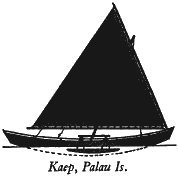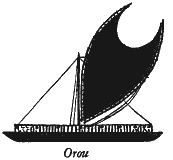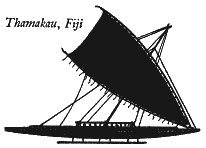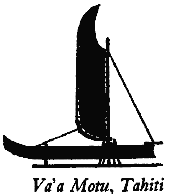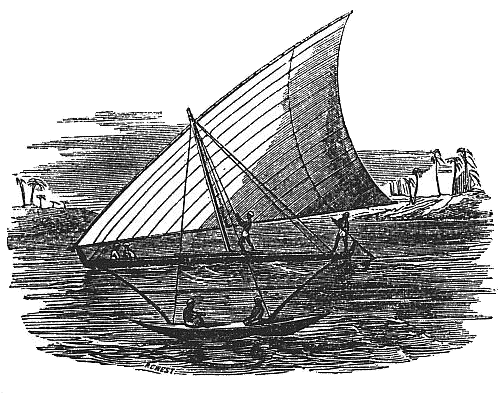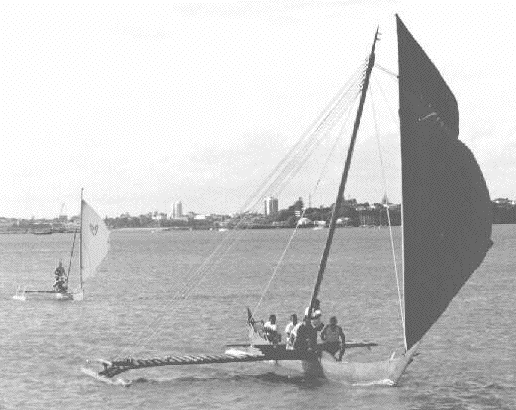| |
|
Cheap Guitars, Sailing
Canoes, Chinese Lugsails, Plywood Boats |

|
A PROA is a Pacific sailing canoe with a single outrigger. They are thousands of years old, beautiful, and fast. A few of 'us' are so taken with them that we're building modernized, westernized versions. That's nothing new. Several proas were built a hundred years ago by Commodore Ralph Munroe and others. See: American Proas Wondering how the Gilbertese engineer their akas and platform? See this excellent short essay from 1945: Gilbertese Canoes Keep reading to find out about my own proa experiments. See my proa FAQ for much more about these wonderful sailing canoes, including drawings, articles, books and many links. I have to admit that I've done so much reading and researching since early 1997 that I'm hard pressed to keep the FAQ updated, but Version 2.0 will appear. I promise: The Proa FAQ
WHEN DISCUSSING proa parts, the ama is the float, the crossarms are akas, and the main hull is a vaka, waka, wangka.
1998 I FINALLY decided on an experimental proa design. More details are coming, but in brief it's a Bolger-style sharpie hull 2 feet wide and 17 feet long; conicidentally that's within a few inches' beam of the classic 1890's sailing canoe. The thought did occur to me that it might make a lousy proa, in which case, with additional topsides of plywood, it might indeed become a westernized sailing canoe. The idea behind this first experiment is to take a windsurfer sail and try that. (Though there are five mast steps, total, a daggerboard trunk and a leeboard bracket). The ama will support a seat of sorts, so in a sense what you'll have is a sit-on-top windsurfer arrangement. Though "crouch" is probably a better description. Park your butt on the seat to windward of the main hull and steer just as you'd normally steer a windsurfer.
WE'LL see. MY 1997 experiment consisted of a "tacking proa": main hull was a 15-foot Coleman green plastic canoe; ama is based on Phil Bolger's slab-sided, flat-bottomed sharpie designs. In fact, I have a Proa-Matic spreadsheet which will give you the dimensions of the bottom and sides if you select a beam (width). The ama was lashed onto the boat in the Pacific tradition. The Coleman is pretty much useless for anything except conversion to a proa, if you ask me. It's impossible to paddle, and I used it before as a junk-rigged sailing boat. Because it's experimental the ama is quite short, about 7 feet 10 inches. It has bow and stern watertight bulkheads and the center section is open for adding weight or storing things if necessary; the open part will be decked over with a couple hatches. It was made from lauan plywood, construction scraps, System Three epoxy and some fiberglass tape. In the end the main complaint was simply that a Coleman
doesn't have enough places to fasten the extra gear. Two of them might
make a double canoe well enough with a large platform of wood to bolt
and screw things to. TED WARREN's 21-ft Tiny Dancer
is the design-and-materials opposite of anything I've done or really
plan to do (fully engineered, computer-simulated, vacuum-bagged,
composite-built, fiber-sparred, dual carbs, the whole enchilada) and a
great looking little boat: Tiny
Dancer. THE MAGAZINE Multihulls has
about a dozen pages on proas in the issue Nov-Dec 1997. Snag it fast,
they don't do this often. Tiny Dancer is there, Michael
Schacht's and Peter Fynn's proas are there, and more. AMAS can also be made from those
split-rail-fence fence rails. They're about 10 feet long and sharp on
both ends, cost about $5 each. Four of them are cut from a small log,
so there's a round part and two flat sides. Use either the round part
down or the point down and you have a round-bottom or V-bottom ama. I
hope to get a couple photos posted showing my 'experimental proa' with
this rig. If you want more weight to the ama, lash two together and
lash those to the akas. You can also use those round-sided yellow pine
garden "ties" which sell for even less, but they are not as long. HOW ABOUT a sail? Man, I need to get around to this. I'm fooling with the Tahitian "half-claw" and the more usual delta-shaped crabclaw. These silhouettes of traditional Pacific rigs show the major sail shapes.
|
|
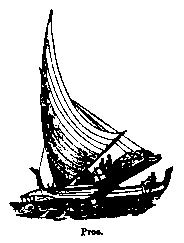 A proa. Sorta. Anudda sorta proa: 1854.
Ralph Munroe's Proa, 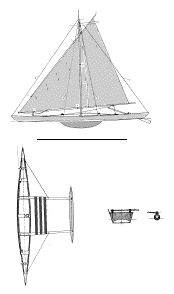
Mr. Roosevelt's
|
|
|
|
|
